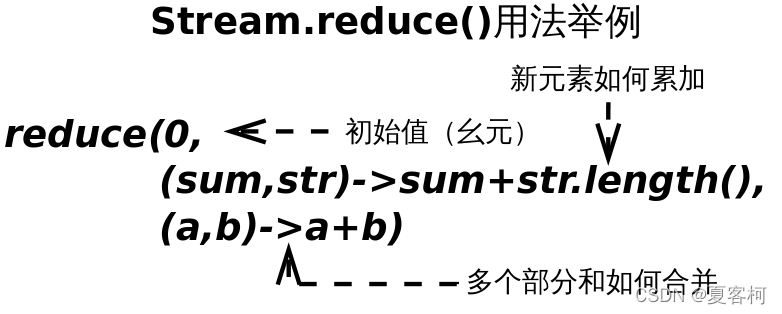reduce()这个方法可能平时用得不多,因为它的常用方法都被单独封装起来了。比如sum()、max()、min()、count()都是通过reduce()操作的。
reduce()是下面三个方法
Optional<T> reduce(BinaryOperator<T> accumulator)
T reduce(T identity, BinaryOperator<T> accumulator)
<U> U reduce(U identity, BiFunction<U,? super T,U> accumulator, BinaryOperator<U> combiner)主要功能 是单参数方法的 ,下面两个一个增加初始值identity,一个是增加并行处理时,多段值的操作。

下面 看例子:
//找出最大数
Optional<Integer> student = Stream.of(1, 2, 3, 4, 5, 6).reduce((v1, v2) -> v1 > v2 ? v1 : v2);
System.out.println(student.get());上面输出结果:
6两个参数的测试:
//设置一个默认值,从默认值开始处理
Integer result = Stream.of(1, 2, 3, 4, 5, 6).reduce(0, (v1, v2) -> v1 + v2);
System.out.println(result);输出结果:
21下面看三个参数例子:
Integer studentId = Stream.of(1, 2, 3, 4, 5, 6).reduce(0,
(sum, v) -> {
return sum + v;
},
(s1, s2) -> s1 + s2);输出结果:
21如果在不使用并行处理的时候,三个参数跟两个参数的方法功能一模一样,而且后面s1跟s2的处理不起到 任何作用的,当加上并行处理 后,结果可以处理多个并行处理的结果再次 处理 ,下面再来个例子 :
Integer studentId = Stream.of(1, 2, 3, 4, 5, 6).parallel().reduce(0,
(sum, v) -> {
return sum + v;
},
(s1, s2) -> s1 * s2);
System.out.println(studentId);处理结果:
720将 多个并行 处理结果相乘